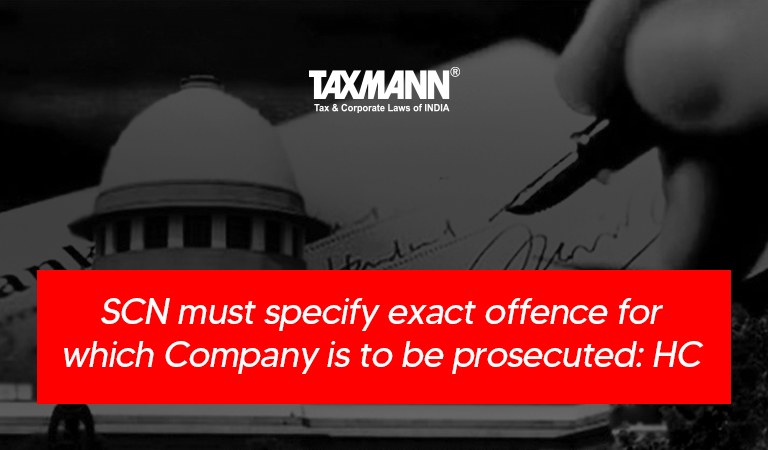SCN must specify exact offence for which Company is to be prosecuted: HC
- Blog|News|Company Law|
- 2 Min Read
- By Taxmann
- |
- Last Updated on 14 May, 2022

Case Details: Khivraj Motors (P.) Ltd. v. Deputy Registrar of Companies - [2022] 138 taxmann.com 165 (HC-Madras)
Judiciary and Counsel Details
-
- G. Chandrasekharan, J.
- Abishek Jenasenan & Aparajitha Vishwanath for the Petitioner.
- Dr D. Simson for the Respondent.
Facts of the Case
In the instant case, the respondent filed the complaint against the petitioners under Section 205C read with Section 629A of the Companies Act, 1956 alleging that as per the balance sheet of the petitioner company for the F.Y. ended 31.03.2013, there was an unpaid dividend amount lying of Rs.10,00,000/-. Whereas, section 205 C of companies Act 1956 required that this amount should be credited to the “Investors Education and Protection Fund”.
Further, as per the Investors Education and Protection Fund Rules, 2012 every company was mandated to identify the unclaimed dividend amount within a period of 90 days after holding of AGM or the date on which AGM ought to have been held till the completion of the period of seven years. Further, the company was required to separately furnish each year a statement of information through E Form- 5 INV, and get it uploaded on its own website and on the MCA.
However, petitioners failed to file E form 5 INV as per the rule. Thereafter, a show cause notice (SCN) was issued on 21.07.2014, however, no reply was received from the petitioners. Therefore, petitioners were held liable to be prosecuted for the aforesaid offence.
Learned counsel for the petitioner submitted that the show cause notice dated 21.07.2014 was silent as to period and as to which of the amounts mentioned under Section 205 C of the Companies Act 1956 was not credited to the Investors Education and Protection Fund. It was also noted that no complaint regarding the unpaid dividend was received from any shareholder of the company. Therefore, the complaint is liable to be quashed.
High Court Held
The High Court held that though the amounts referred under Section 205C were held liable to be credited to Investors Education and Protection Fund. However, the Show cause notice was not specific about which one among these amounts was liable to be credited to the Fund. In so far as the petitioner’s company, the allegation against the petitioners was that unpaid dividend amount of Rs.10,00,000/- for the period ending 31.3.2013 was not uploaded in the website. Then, the show cause notice was expected to refer only that particular default committed by the petitioners.
Further, the reproduction of part of Section 205C of the Companies Act, 1956 cannot be appreciated. There was substance in the submission of the learned counsel for the petitioner company that because of this ambiguous nature of show cause notice, petitioners were not able to give a proper reply. Therefore, due to this faulty show cause notice, the complaint was liable to be quashed. Further, launching prosecution without considering company’s reply to show cause notice amounts to non-application of mind. That was also a ground for quashing the complaint.
Disclaimer: The content/information published on the website is only for general information of the user and shall not be construed as legal advice. While the Taxmann has exercised reasonable efforts to ensure the veracity of information/content published, Taxmann shall be under no liability in any manner whatsoever for incorrect information, if any.

Taxmann Publications has a dedicated in-house Research & Editorial Team. This team consists of a team of Chartered Accountants, Company Secretaries, and Lawyers. This team works under the guidance and supervision of editor-in-chief Mr Rakesh Bhargava.
The Research and Editorial Team is responsible for developing reliable and accurate content for the readers. The team follows the six-sigma approach to achieve the benchmark of zero error in its publications and research platforms. The team ensures that the following publication guidelines are thoroughly followed while developing the content:
- The statutory material is obtained only from the authorized and reliable sources
- All the latest developments in the judicial and legislative fields are covered
- Prepare the analytical write-ups on current, controversial, and important issues to help the readers to understand the concept and its implications
- Every content published by Taxmann is complete, accurate and lucid
- All evidence-based statements are supported with proper reference to Section, Circular No., Notification No. or citations
- The golden rules of grammar, style and consistency are thoroughly followed
- Font and size that’s easy to read and remain consistent across all imprint and digital publications are applied





